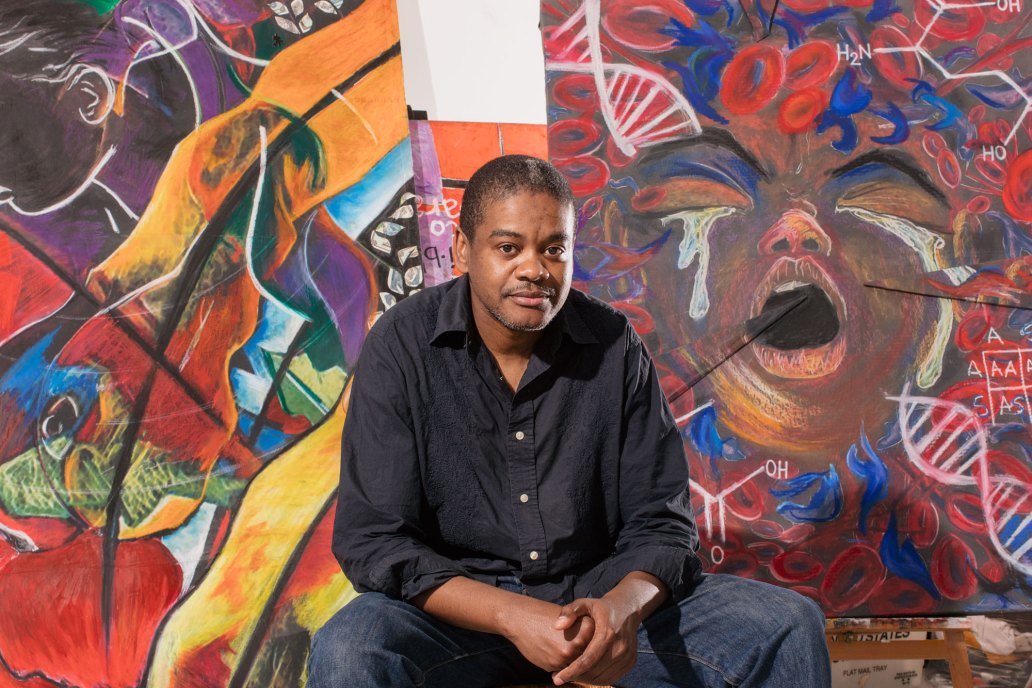World Sickle Cell Day Celebrates Patients, Raises Awareness
Written by |

Painter Hertz Nazaire, (Photo courtesy of Hertz Nazaire)
Supporters are poised to mark World Sickle Cell Day, observed each June 19 to raise awareness about the red blood cell disorder, and to raise funds to fight it.
Across the globe, supporters will participate in activities such as wearing red for sickle cell disease (SCD), sponsoring a walk or run, shaving or dying their hair, and sharing patient stories with local media outlets.
Organized by the U.K.-based Sickle Cell Society, the event also is an opportunity to support and celebrate the achievements of those with sickle cell.
“World Sickle Cell Day is the perfect opportunity to run an event or fundraiser to let people in your community know more about sickle cell and help support those living with the disorder,” the society states on its World Sickle Cell Day webpage.
Because the COVID-19 pandemic puts these patients at risk of complications, the Sickle Cell Society is advising World Sickle Cell Day participants to wear masks and practice proper social distancing during in-person activities.
Fundraising ideas include: teaching an online class; making a video of hair being shaved or colored; doing a “24hr-a-thon” where participants do a certain activity for 24 hours; or organizing a run, walk, or bike ride. Participants are asked to complete form (found here) and send it to [email protected]. Proceeds benefit the Sickle Cell Society, which advocates for and supports SCD patients to improve their care and quality of life.
The organization will publicize individual online events across Twitter, Facebook, and Instagram, and encourages supporters to send photos of activities for posting, using the hashtag #WorldSickleCellDay and tagging @SickleCellUK. To help raise awareness, it also suggests that participants alert local newspapers of fundraising efforts.
Supporters are asked to wear something red — the official SCD color — to spark conversations about sickle cell. They are encouraged to take photos of themselves in the attire and post them on social media.
The society also has made available prepared texts of SCD facts, plus an array of downloadable fact-filled graphics. For even more sickle cell facts and statistics for sharing, visit this link.
Faces of World Sickle Cell Day
Amatullah Tyler has a type of SCD called hemoglobin SS, the most common and often most severe form of the disease. The 16-year-old Hampton, Georgia, resident spoke about her condition with Sickle Cell Disease News by phone.
“I’ve never had major complications, but I have had pain crises. They can be the worst pain I’ve ever felt,” said Amatullah, who has two younger sisters with SCD.
“The last two started in my diaphragm area. It felt like I couldn’t breathe. It felt like someone was pinching me,” she said.
It was a painful vaso-occlusive crisis that resulted in a week-long hospitalization early this year. As often happens with SCD patients, once Amatullah’s pain was under control, acute chest syndrome developed. Several days were spent stabilizing her breathing and oxygen levels.
After that hospitalization, Amatullah began taking Oxbryta (voxelotor), approved by the U.S. Food and Drug Administration (FDA) in November 2019 to treat SCD in individuals 12 and older. Developed by Global Blood Therapeutics, Oxbryta is the first treatment to target the root cause of sickle cell. Specifically, the once-daily oral tablet works to stop the sickling and destruction of red blood cells that mark the disease. So far, so good, Amatullah says.
She had been on Oxbryta and hydroxyurea, used to reduce the frequency of pain crises and the need for blood transfusions in SCD. But trouble swallowing hydroxyurea, along with nausea, caused her to drop it. And fertility issues associated with the medicine were worrisome. For years, hydroxyurea was the only FDA-approved option for treating SCD.
“Hydroxyurea has been wonderful for the SCD community, but it wasn’t the best option for a lot of people,” said Mapillar Dahn, Amatullah’s mother. Her youngest daughter, Hajar Tyler, 10, continues to take hydroxyurea and has never had SCD symptoms. “That is highly unusual, and a blessing,” Dahn said.
Her middle daughter, Khadeejah, had a stroke due to SCD at age 7. To prevent another one, the 14-year-old has monthly blood transfusions and takes Jadenu (deferasirox) to avoid potentially organ-damaging iron buildup in the blood .
Access to care
Because of critical blood shortages due to the COVID-19 pandemic, transfusions have become challenging in some areas. That’s a concern for Liberia-born Dahn, who moved to the U.S. in 1997.
“We encourage the black community to give blood, because black people are disproportionately affected by SCD,” she said.
Four years ago, the self-employed marketer founded the MTS Sickle Cell Foundation to raise awareness, assist in education and research, and provide support for affected families. MTS stands for “My Three Sicklers.”
“As a single mom of three daughters who’s in the trenches, I know what it’s like to have no organization to turn to when life happens,” said Dahn, whose mother lives with her to help out. “SCD is very unpredictable. One minute things are okay, the next minute someone’s in the hospital for a week.”
Through the MTS Sickle Cell Foundation COVID-19 Patient Financial Aid Program, in the past two months, the organization has been able to help more than 500 families affected by the pandemic and has even provided masks. The foundation is funded by individuals and companies, including Global Blood Therapeutics.
Dahn plans to expand her efforts to impoverished areas such as sub-Saharan Africa, where 80% of all SCD patients are born, and where as many as half die before age 5 due to preventable complications.
Addressing stigmas
As part of its awareness mission, World Sickle Cell Day aims to cut through stigmas or misconceptions faced by SCD patients, who often end up feeling isolated and misunderstood. Largely due to cultural barriers and misinformation, some people believe that SCD is contagious, or that all patients have pain crises.
Some perceive patients as seekers of opioids, which those with SCD sometimes need for pain. Dahn knows firsthand about these perceptions. “Sickle cell is a harsh disease,” she said. “We struggle as a community with people taking us seriously. You have people told they’re faking their disease, ‘You were just here, why are you back? You’re just here for the drugs.’ It’s a stigma.”
However, a 2016 study, published in the journal Pain Medicine, showed there were markedly fewer SCD patients who died due to opioid overdoses than patients with other diagnoses.
Art from pain
World Sickle Cell Day celebrates those patients who have survived, and even thrived. Enter Hertz Nazaire, a painter, SCD advocate, and 46-year-old sickle cell patient. Born in Haiti, the Bridgeport, Connecticut, resident has had a lifetime of dealing with SCD. He has “flatlined” in the hospital twice, lost sight in his right eye, and had his gallbladder removed.
For a decade, Nazaire’s sole treatment was a transfusion exchange, whereby some of his blood is replaced with donor blood. He started on Oxbryta last year. Yet, art also has been an effective therapeutic. He began painting when he was a child.
“It helped me cope with my SCD and to go somewhere else in my mind,” he said. “Sometimes when I draw or paint, I forget about all the issues I’m having.”
Nazaire favors vibrant colors and flowers in his paintings, reminiscent of his native Haiti. He also likes to incorporate aspects from other cultures.
Although his creativity is hampered by partial blindness, Nazaire recently created a two-volume fine art adult coloring book of his line drawings called “Finding Your Colors.” Such a book could be particularly helpful during the pandemic, when many people are homebound.
“People seem to like it,” he said of the coloring book. “People send me pictures after they color them. Sometimes they color at the hospital.”







